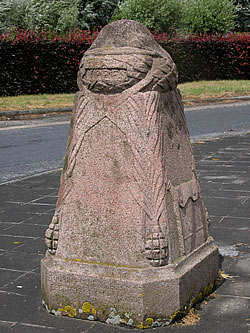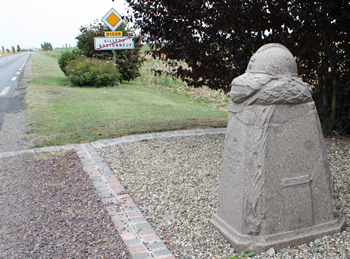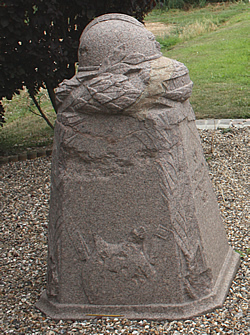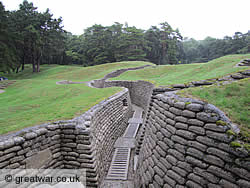Demarcation Stone Monuments/Bornes du Front

|
Demarcation Stones are a series of sculpted stone monuments to be found along the battle line of the Western Front in Belgium and France. In Belgium the stones are called “Demarcatiepalen”. In France they are named “Bornes du Front”.
The idea for these stones was first introduced in 1920 by the French sculptor Paul Moreau-Vauthier(1). Before the First World War he was well-known as he had created the statue “La Parisienne” which stood on top of the magnificent arch at the entrance to the Exposition Universelle 1900, the Paris World's Fair. In 1909 he had created a monument to commemorate the first cross-Channel flight in an aeroplane piloted by the Frenchman Louis Blériot.
During the First World War Paul Moreau-Vauthier served in the French Army and was in action at the Battle of Verdun.
A Line of Monuments
Paul Moreau-Vauthier's proposal for a memorial to the First World War was for a series of small monuments to be located in certain places to commemorate the line of departure from which the Allies had launched their victorious offensive against the German Army in the summer of 1918.
The original idea was to place a stone monument for every kilometre at a relevant location along the 650 kilometre (400 mile) line of the Western Front battlefields from Nieuwpoort on the Belgian coast to its end-point at Pfetterhouse on the French-Swiss border.

|
In 1920 Paul Moreau-Vauthier created a model of the stone monument he had in mind and invited Henri Defert to see it. Henri Defert was president of the Touring Club de France(2). Henri Defert was very interested to support the idea and he asked the Touring Club de Belgique(3) to be associated with the scheme too. The Ypres League(4) was also invited to take part in the scheme and to raise funds for markers in Belgium.
General Philippe Pétain(5) was invited to be involved with the decisions for establishing the locations for the marker monuments. A list of 240 stones and their proposed locations was drawn up. 28 markers were planned for the Belgian part of the Western Front line of early summer 1918, with 212 planned for the French part of the line.
To begin with there was great enthusiasm for the idea and funding for the project was supported by subscriptions from the general public in France and Belgium. The first Demarcation Stone monument in France was inaugurated on 11th November 1921 at Château-Thierry in the Department of the Marne. More Demarcation Stones were put in position along the Western Front, but the public support for the project began to wane before the project was complete.
118 Demarcation Stones were put in place over seven years from 1921 to 1927; 22 in Belgium (16 funded by the Touring Club de Belgique and 6 by the Ypres League) and 96 in France (funded by the Touring Club de France). The last of these was placed on the mountain called Vieil-Armand in the south of the Vosges mountain range. This mountain had been named Hartmannsweilerkopf by the German Army. It had been the scene of fierce fighting between the French and German Armies in the later months of 1914 and early 1915. Two more stones were put up in 1929 and 1930, however the completion of the line of over 200 monuments every few kilometres along the Western Front was never finished due to the lack of funds.
During the Second World War 24 of the Demarcation Stone monuments were destroyed (three stones in Belgium and 21 in France). Some have since fallen into a poor condition.
Demarcation Stone Features

|
Each monument is one metre high. On top there is a laurel wreath and a Belgian, British or French helmet depending on the Allied troops which had been holding the sector where it was located.
On the left and right sides of the monument there are two pieces of equipment used by the fighting soldier in the form of a carved water bottle and a case for a gas mask.
A grenade and flame bursting out of it is carved on each of the four corners.
On the monument there is usually an inscription “Ici fut repoussé l'envahisseur”, which translates as “From here the invader was pushed back”.
Location of Demarcation Stones
Featured on greatwar.co.uk
Demarcation Stones are featured on this website within the listings of monuments in the battle areas as follows:
Demarcation Stone No. 7 Dodengang (Yser Battlefield, Belgium)
Demarcation Stone No. 15 Hellfire Corner (Ypres Salient, Belgium)
Demarcation Stone No. 16 Zillebeke (Ypres Salient, Belgium)
Demarcation Stone No. 23 Villers-Bretonneux (Somme, France)
Related Topic

WW1 Monuments & Memorials on the Western Front Battlefields
Acknowledgements & Sources
(1) Paul Moreau-Vauthier was born on 26 November 1871. He died in a car accident on 2 February 1936.
Website: en.wikipedia.org Paul Moreau-Vauthier
(2) The Touring Club of France was founded in 1890 at Neuilly-sur-Seine with the aim of developing tourism in all its forms. It was responsible for the development of many of the now famous tourist routes for cars, bicycles and walkers in France. The Club also played a major part in the development of road signs throughout France in the first half of the twentieth century.
(3) The Touring Club de Belgique was founded in 1895. It was the first official tourist organization in Belgium. The club provided its members with a Bulletin which offered routes to follow in the countryside or cities as excursions and trips to visit places of interest. The routes in the bulletin were displayed as road maps, descriptive text and photographs. (Source: From monument to landscape and back again, Bruno Notteboom)
(4) The Ypres League was founded on 28 September 1920. It was a British society with the aim of giving the many thousands of veterans who had served on the Ypres Salient battlefields an organization to help them meet with one another, remember their comrades and to help pilgrims wishing to visit the graves and cemeteries in that battlefield area. It was involved in the founding of St. George's Memorial Church in Ypres.St. George's Memorial Church in Ypres
(5) General Pétain (1856-1951) was a distinguished war hero to the French people. He had been Commander of the French Second Army when the Battle of Verdun began in February 1916. He was promoted to command the Army Group Centre and its 52 divisions during the battle. Paul Moreau-Vauthier was a veteran of the Battle of Verdun.
Rik Scherpenberg: Very grateful thanks are extended to Rik Scherpenberg and his comprehensive study of the Demarcation Stones on his website. (As at January 2023 the link to Rik's website is not available for sites.google.com demarcationstonesww1 - wraros)